Reign 1210– 30 April 1236 Religion Islam Successor Rukn ud din Firuz | Name Shams-ud-din Iltutmish Spouse Shah Turkan (m. ?–1236) | |
 | ||
Died May 1, 1236, Delhi, New Delhi Children Razia Sultana, Rukn ud din Firuz, Muiz ud din Bahram, Nasiruddin Mahmud Place of burial Tomb of Iltutmish, Qubbat-ul-Islam Mosque Grandchildren Ala ud din Masud, Zubrudin Mirza Rashil Similar Rani Padmini, Alauddin Khilji, Malik Kafur | ||
The tomb of shams ud din iltutmish qutab complex
Shams ud-Din Iltutmish (r. 1211 – 1236) was the third ruler of the Delhi Sultanate, belonging to the Mamluk dynasty. Iltutmish consolidated the position of the sultanate in the Indian subcontinent.
Contents
- The tomb of shams ud din iltutmish qutab complex
- Iltutmish tomb at qutub complex
- Name
- Early life and career
- Early challenges
- Mongol threat
- Consolidation of power
- Architecture
- Coinage
- Iqtadar
- Islamic Culture
- Nobility
- Death and succession
- References

He conquered Multan and Bengal from contesting rulers, and Ranathambhore and Siwalik from their rulers.
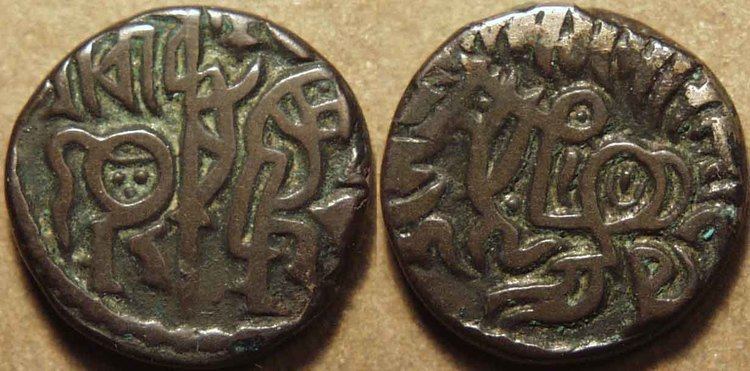
He expanded his domain by defeating the Muslim rulers of Ghazni, Multan and Bengal, which had previously annexed some of his territories and threatened his domain. He conquered the latter two territories and made further conquests in the Hindu lands, conquering the fort of Ranathambhore and the lands of Gwalior and the fort of Mandur.
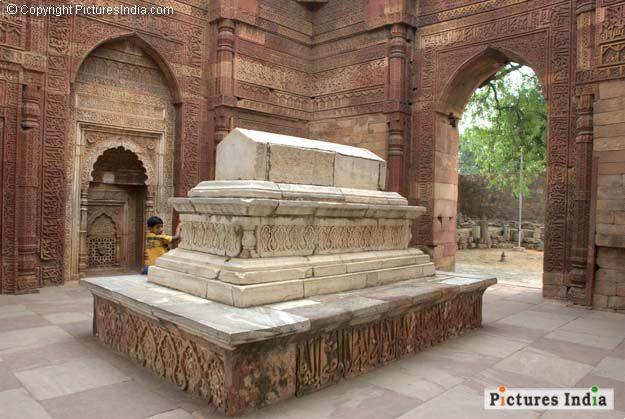
He instituted many changes to the Sultanate, re-organising the monetary system and the nobility as well as the distribution of grounds and fiefs, and erected many buildings, including Mosques, Khanqas (Monasteries), Dargahs (Graves) and a Hauz (reservoir) for pilgrims.

Shams ud-din Iltutmish founded the Delhi Sultanate and much strengthened the power of the slave dynasty and of Islam in the India, although his kindred and heirs were not as politically gifted, with no ruler comparable to him in the area until the time of Ghiasuddin Balban.
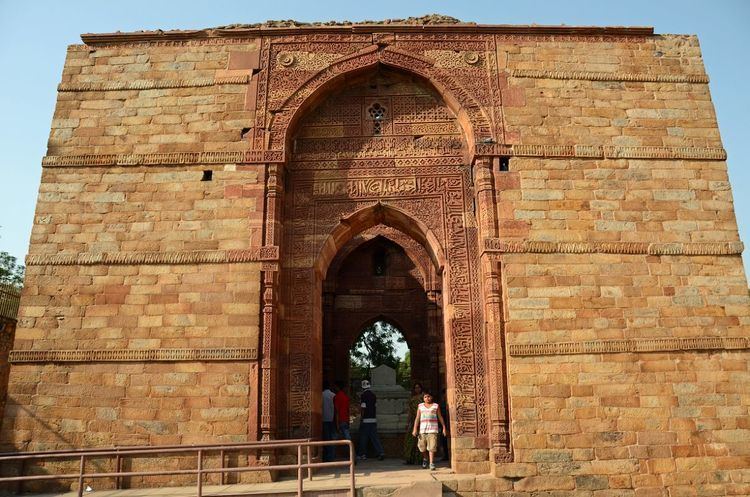
Iltutmish tomb at qutub complex
Name
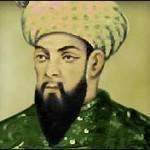
The name Iltutmish is a Turkic name, meaning "he has held/owned land" (İltutmuş, in modern Turkish). Another theory concerning the meaning of the name suggests a connection with an eclipse that supposedly occurred at his birth (an event of some importance in the view of the people of the time). The other etymologies for his name include Altamash, which donates the number sixty, or the guard of the army, which is the ancient Turkic Khanates numbered at sixty; but this theory falsely draws its source from that he is often referred to as "Al-Tamash", which is most likely an Arabic variation of his Turkic name.
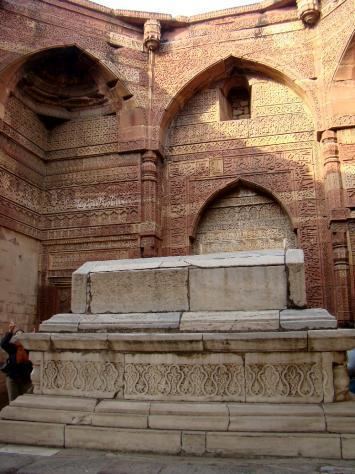
The title "Shams ad-Dunya Wa'd-Din" is a royal Laqab (regal title) of the time, translated as "Sun of the world and [of the] Faith" which Iltutmish used once he was established as the sultan of Delhi. Subsequent to the investiture by the Caliph, he was also addressed by the title "Yamin Amir al-Mu'minin" - the right-hand man of the Commander of the Faithful, or as "Naib" (lieutenant) of the Commander of the Faithful, which is the Caliph.
Early life and career
Shams ud-Din Iltutmish belonged to the Ilbari tribe in the Eurasian steppes of Turkestan. While his association (by his biographers) with the Turkic nobility of that tribe can be seen as dubious and anachronistic, it is possible that he was indeed high-born.
Iltutmish was sold into slavery at an early age, reportedly after being sold by his kinsmen to slave merchants. He was apparently handsome and particularly intelligent, causing jealousy among his brothers (a motif admittedly taken from the Biblical and Quranic tale of Joseph). Slave merchants would supply Turkic slaves as soldiers (ghilman) to the military elite of the Muslim world at the time.
Iltutmish was taken to the great slave market of Bukhara, and later to Ghazni, a capital of the Ghurid dynasty. In Ghazni he was purchased by the court of the ruler of the Ghurid Empire at the time, Mu'izz ad-Din Muhammad Ghori (commonly known as Muhammad of Ghor). Earning some reputation in his court, he was quickly appointed personal attendant of Mu'izz ad-Din.
Mu'izz ad-Din's deputy and former slave, Qutb al-Din Aibak, then Viceroy of Lahore, sought to procure Iltutmish. Due to the Mu'izz ad-Din's refusal to sell his slaves to his nobles, it was decided that Iltutmish be taken to Delhi, and would be bought by Aibak there, so that Mu'izz ad-Din's orders would not be violated in his own capital. Aibak bought Iltutmish and another slave (who would later perish) for the high price of 100,000 Tankas (Tankas were the silver coins used in the Delhi Sultanate at the time).
Iltutmish rose quickly in Aibak's service, earned the title Amir Tamghach, married Aibak's daughter, and served in succession as the Governor of Tabarind, Gwalior and Baran. In recognition of his services during Mu'izz ad-Din's campaign against the Khokhars in 1205-06, he was, by Mu'izz ad-Din's order, manumitted. Iltutmish was then appointed Governor of Badaun in 1206 and was serving in this post when Aibak died in a chaugan accident and was succeeded by Aram Shah in 1210. Subsequently, a group of forty Turkic nobles known as "Chihalgani" who opposed Aram Shah invited Iltutmish to become sultan of Delhi. Both Aram Shah and Iltutmish marched towards Delhi from Lahore and Badaun respectively. They met on the plain of Bagh-i-Jud near Delhi in 1211, where Iltutmish defeated Aram.
Early challenges
On his accession, Iltutmish faced a number of challenges to his rule. In the aftermath of Aibak's death, the Ghurid dominions in India had divided into four. Iltutmish controlled Delhi. Nasir ad-Din Qabacha, the Governor of Uch and Multan, asserted his independence. Ali Mardan Khilji, who had been appointed Governor of Lakhnauti in Bengal by Aibak in 1206, had thrown off his allegiance to Delhi after Aibak's death and styled himself Sultan Ala ud-Din of Bengal. Lahore was contested by Iltutmish, Qabacha and Taj al-Din Yildiz, who asserted his rights as the successor to Mu'izz ad-Din Muhammad Ghori in Ghazni. Yildiz attempted to bring Delhi under his control. Initially, Iltutmish acknowledged Yildiz's suzerainty by accepting the symbolic presents of the chatr and durbash. The Hindu princes and chiefs were discontented at their loss of independence and had recovered Kannauj, Benaras, Gwalior, and Kalinjar, all of which had been lost during Qutb al-Din's reign. Ranthambore had been reconquered by the Chauhans during Aram Shah's rule. To add to Iltutmish's troubles, some of the Turkic nobles in Delhi expressed resentment against his rule.
The first order of business was to bring under control dependencies of Delhi that were under the control of nobles appointed by Mu'izz ad-Din and Hindu chieftains. Iltutmish launched military campaigns to assert his rule over Awadh, Badaun, Benaras and Siwalik. Iltutmish's son Nasir ud-Din Mahmud captured the Gangetic valley territories of Badaun, Kannauj and Benaras. Rohilkhand was taken with heavy losses.
In 1215-1216, Taj al-Din Yildiz, who had been defeated and expelled from Ghazni by the forces of the Khwarezmid Empire, moved towards Punjab and captured Lahore from Qabacha. Yildiz laid claim to the throne of Delhi as the heir to Mu'izz ad-Din Muhammad Ghori. Iltutmish refused, stating:
[T]he dominion of the world is enjoyed by the one who possesses the greatest strength. The principle of hereditary succession is not extinct but long ago destiny abolished this custom.
Iltutmish defeated Yildiz at Tarain in January 1216. Yildiz was imprisoned in Badaun and was later executed.
In 1217, after the death of Yildiz, Qabacha had retaken Lahore and in response, Iltutmish led his army towards Lahore. Qabacha attempted to retreat from Lahore towards Multan. Iltutmish refrained from attacking Sindh due to the presence of the Mongols on his north-west frontier. Iltutmish was preoccupied with the Mongol threat and did not threaten Qabacha until year 1227, when he defeated Qabacha at Mansura. Lahore was under Iltutmish's rule but not for long.
Mongol threat
In 1221, the Mongol Empire under Genghis Khan appeared for the first time on the banks of the Indus River. They had overrun central and western Asia with lightning rapidity. The Mongols sacked the Khwarazmid Empire, captured its capital Khiva and forced its ruler, Jalal ad-Din Mingburnu, to flee to the Punjab.
Mingburnu, a staunch opponent of the Mongols, entered into an alliance with the Khokhars and captured Lahore and much of the Punjab. He requested an alliance with Iltutmish against the Mongols. Iltutmish refused, not wishing to get into a conflict with Genghis Khan. He then marched towards Lahore at the head of a large army. Mingburnu retreated from Lahore and moved towards Uch, inflicting a heavy defeat on Qabacha. Mingburnu then plundered Sindh and northern Gujarat before going to Persia in 1224. The Mongols invaded Multan in 1241, but were defeated and left.
Consolidation of power
Loath to get into a conflict with the Mongols, Iltutmish turned his attention towards the Hindu east. Iltutmish marched against Ghiyasuddin in 1225 and was successful. Ghiyasuddin accepted Iltutmish's suzerainty, ceded Bihar, and paid a large tribute. However, soon after Iltutmish left, Ghiyasuddin revoked the agreement and retook control of Bihar. Iltutmish's son Nasiruddin Mahmud, Governor of Awadh was tasked with dealing with Bengal. In 1227, when Ghiyasuddin was campaigning in Assam, Mahmud launched a sudden attack, capturing Lakhnauti. Ghiyasuddin was imprisoned and then executed. Mahmud died suddenly in 1229, to the dismay of his father. This led to further revolts by the Khalji Maliks of Bengal until Iltutmish captured Lakhnauti again in 1230. Ala-ud-din Jani was appointed Governor of Lakhnauti.
Iltutmish then turned his attention to Qabacha. Capture of Bengal and Rajput territories had significantly enhanced the state of Iltutmish's treasury whereas Qabacha had been weakened by Mingburnu's sack of Uchch and the Mongol siege of Multan. The upheaval caused by the Mongol invasion had led to a large number of military adventurers and officers from Turkic lands to move to India. Iltutmish's replenished treasury allowed him to recruit a large army. A number of officials also defected from Qabacha's camp. In 1228, Iltutmish attacked Qabacha. Ucch was captured after a siege of three months. Qabacha fled and was surrounded on all sides in the fort of Bhakkar, on the banks of Indus. He drowned while attempting to escape. Sindh and Multan were incorporated into the Delhi Sultanate and placed under separate governors.
In 1228-29, Iltutmish received emissaries from the Abbasid Caliph Al-Mustansir and was presented with the Caliphal robe (khilat) and investiture (manshur) signifying the Caliphate's recognition of Iltutmish's rule over India. Such recognition was highly sought after by the Muslim rulers of India as it lent religious and political legitimacy and prestige. In Iltutmish's case, in particular, this was a symbolic declaration of the Delhi Sultanate's status as an independent kingdom rather than a client of the Ghurids. and earned Iltutmish the title of "Lieutanat" (Naib) or "righthand man" (Yamin) of the Caliph, or Commander of the Faithfull (Amir al-Mu'minin). Iltutmish also went to Egypt, the seat of the Caliph under the Ayyubid Cairo Sultanate, as part of the mutual delegations between his domain and the Caliphate.
Due to his problems first with Turkic nobles and then with the Mongols, Iltutmish had also ignored the Rajputs, who had regained territory lost earlier to the Turks, for the first fifteen years of his reign. Starting in 1226, however, Iltutmish began a series of campaigns against the Rajputs. Ranthambore, considered impregnable, was taken in 1226; Mandsaur in 1227. Bayana, Ajmer and Sambhar were also captured. Ranthambore was returned to its Chauhan rulers, who served as feudatories, while Ajmer remained part of the Delhi Sultanate. Nagaur was captured in 1230 and Gwalior was captured in 1231 after a one-year siege. Iltutmish's army was forced to retreat with heavy losses from Gujarat by the ruling Chalukyas. In 1235, Iltutmish sacked Ujjain.
Architecture
During his dominion in Badaun, Iltutmish built the city's fort (Kotla) and the Jama Masjid Shamsi (great Friday Mosque) of the city, which remained the biggest and most famous Mosque in Medieval India until the expansion of Delhi's Jama Masjid in Alauddin's time and is still second largest with the largest Mosque Dome.
Shams ud-din built several Khanqas (monasteries) and Dargahs (graves) for Sufi saints, as Sufism was dominant in the Deccan. He commenced the structure of Hamid ud-din's Khanaqa, and build the Gandhak-ki-Baoli, a stepwell for the Sufi saint, Qutbuddin Bakhtiar Kaki, who moved to Delhi during his reign.
Near the Gandhaki Baoli, Shams ud-din also built the Hauz-i-Shamsi, a watertank (a popular means for the welfare of pilgrims), which he erected in 1230 after the Prophet Muhammad was claimed to have appeared in his dream and led him there. Iltutmish claimed to have found the footprint of the Buraq, the prophet's mount, at the site. The site also encompasses the Jahaz Mahal standing on its edge, used by later Mughal Emperors.
In 1231, following the demise of his oldest son and heir apparent, Nasir ud-Din Mahmud, he built Sultan Ghari the mausoleum for him, which was the first Islamic Mausoleum in Delhi. The tomb lies within fortified grounds, which also include the graves of several others of Iltutmish's kindred.
He is said to have completed the construction of the Qutb Minar, erected by Qutb ud-din, and expanded the Qutb complex and the Quwwat al-Islam Mosque therein.
Coinage
The early Ghurid rulers had maintained the Rajput coinage system based on the Hindushahi bull-and horseman coins in place at the Delhi mint. Dehliwala, the standard coin, was a silver-copper alloy with a uniform weight of 3.38 grams, of which 0.59 grams was Silver. The major source of silver for the Delhi mint were coin hoards from Central Asia. Another source was European silver which made its way to Delhi via the Red Sea, Persian Gulf through the ports of Gujarat. By the 1220s, supply from Central Asia had dried up and Gujarat was under control of hostile forces.
In response to the lack of silver, Iltutmish introduced a new bimetallic coinage system to Northern India consisting of an 11 grams silver Tanka and the billon Jital, with 0.25 grams of silver. The Dehliwala was devalued to be on par with the Jital. This meant that a Dehliwala with 0.59 grams of silver was now equivalent to a coin with 0.25 grams of silver. Each Dehliwala paid as tax, therefore produced an excess 0.34 grams of silver which could be used to produce Tankas. The new system served as the basis for coinage for much of the Sultanate period and even beyond, though periodic shortages of silver caused further debasement. The Tanka is a forerunner to the Rupee.
Iqtadar
Iltutmish introduced the Iqta-dar system, which had been the common practice of the majority of the Islamic world since the time of the Buyids. The system shares some similarities with the contemporary European custom of Feudalism, and involved dedicating the profits of a certain land of fief (Quta'/Iqta' in other Islamic lands) to warlords in payment of their martial service and political loyalty. It was basically grant of revenue from a territory instead of a salary.
Islamic Culture
Shams ud-din's court was abundant with poets in the Arabic and Persian languages. He is said to have rewarded a poet called Nasiri for writing him a fifty-three couplets long Qasida, by giving him fifty-three thousands Tankas; Iltutmish is also said to have learned the opening (Fatiha) of the Qasida by heart. His victories against the Hindu Rajputs of Ranathambhor was celebrated by the poet Ruhani al-Samarqandi to devote these verses to the Sultan:
The faithful Gabriel carried the tidings to the dwellers in heaven,From the record of victories of the Sulṭán of the age Shams ud-Dín,Saying — Oh ye holy angels raise upon the heavens,Hearing this good tidings, the canopy of adornment.That from the land of the heretics the Sháhansháh of IslámHas conquered a second time the fort resembling the sky;The Sháh, holy warrior and Ghází, whose hand and swordThe soul of the lion of repeated attacks praises.The verses compare the Sultan to 'Ali, who is often called Asad-Illah (or Shir-i Khuda), and adornes him with the Persian title of Shanshah (King of Kings) and clearly refer to Ranathambor as "the fort resembling the sky", due to its high position in the mountains. The famous poet, Amir Khusraw, was a poet in the service of his court, as well, and has mentioned the Sultan in verses often.
Nobility
Shams ud-din installed a new nobility, which was based on a confederation of Turkic and a few Mawali (new Muslims of Hindu origin) that were acquitants of him or of Qutb ud-din. They formed a council of forty (Chilanghan) which was very powerful and became the de facto rulers behind the majority of his heirs.
Death and succession
In 1236 Iltutmish died, and was buried in the Qutb complex in Mehrauli.
The death of Iltutmish was followed by years of political instability at Delhi. During this period, four descendants of Iltutmish were put on the throne and murdered. Iltutmish's eldest son, Nasir-ud-din Mahmud, had died in 1229 while governing Bengal as his father's deputy. The surviving sons of the Sultan were incapable of the task of administration. In 1236, Iltutmish, on his death-bed, nominated his daughter Razia as his heiress. But, Razia did not have support of the nobles of the court, who did not want a woman ruler.
Iltutmish's eldest surviving son, Rukn-ud-din Firuz was raised to the throne. Firuz left governance in the hands of his mother, Shah Turken. Firuz was deposed within six months, and Razia became the ruler. Razia's growing assertiveness brought her in conflict with the nobles. In 1240, a rebellion led to the replacement of Razia by her brother, Muiz ud din Bahram. Bahram ruled for two years before he was overthrown in favour of Firuz's son, Ala ud din Masud in 1242.
Order was re-established only after Iltutmish's grandson Nasir-ud-din-Mahmud became Sultan with Iltutmish's prominent slave, Ghias-ud-din-Balban as his Deputy Sultan (Naib) in 1246. Balban held all the power at the time and became Sultan in 1266. There was internal stability from 1246 until 1290 when Jalal-ud-din Khilji overthrew Balban's great-grandson Kayumarath, thus ending the Mamluk Dynasty and founded the Khilji Dynasty.
